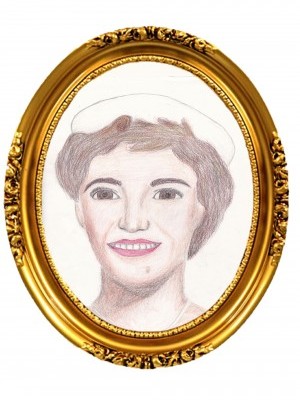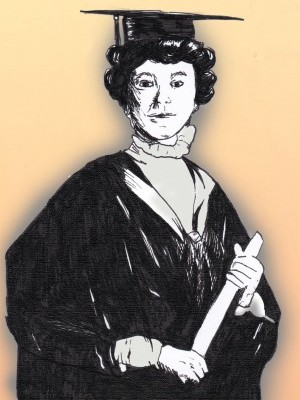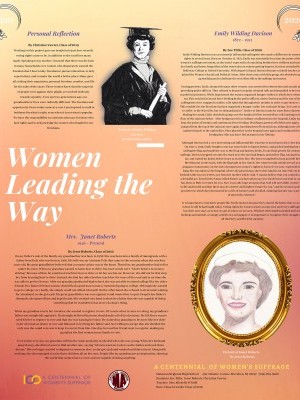Christina Vawter, Jesse Roberts, Zoe Tillis
Matawan Regional High School | Aberdeen, NJ | 12th Grade
Inspirational Family Member
My Grandmother Mrs. Janet Roberts
On my father’s side of the family, my grandmother was born in 1936. She was born into a family of immigrants with a father from Italy who was born in 1902. His wife was an Austrian-Pole that came to this country when she was four years old. My great-grandfather believed that a woman’s place was in the home. Therefore, my grandmother had to live under his rules. When my grandma wanted to learn how to drive, his exact words were “I don’t believe in women driving.” Because of that, he would not teach her how to drive or let her use his car. However, she did not let that stop her from learning how to drive. Instead, she had her older brother teach her the ways of the road and in no time she was able to get her license. After my grandma graduated high school, she was not able to attend college like her other friends. Her father felt that women should find a good man to marry instead of going to college. Although she wanted to go to college very badly, she simply could not afford it herself. On the other hand, she refused to sit around, waiting for a husband, so she got a job. My great grandfather was very against it and wanted her to quit. Despite her father’s demands, she ignored him and kept the job. She worked very hard to show her father that she was capable of doing something that he considered was more of a man’s thing.
When my grandma was in her twenties, she wanted to register to vote. Of course when it came to voting, my grandma’s father was completely against it. He strongly believed that men should make all of the decisions. He felt there was no need for her to register to vote and that she was wasting her time. He wanted my grandma to be more like her older sister who had no desire to vote and followed everything her father said. Not willing to accept this, she decided the only way she could vote was to keep it a secret from him. One day, she and her friend went to register, making my grandma the first woman in my family to vote.
Even to this very day, my grandma still has the same mentality as she did when she was young. When her husband passed away, she did not want to find another one, saying, “All men want me to do is wash clothes and cook them dinner.” She no longer wanted to be dependent on someone else, so she got a job and worked until she retired. Along with working, she also managed to raise three children on her own. People like my grandma are an inspiration, showing the world that women have a voice and are capable of doing anything.
Historical Figure I Admire
Emily Wilding Davison was an extremely influential suffragette, attempting to make a difference in women’s rights in various different ways. Born October 11, 1872, Emily was basically at the prime of the women’s suffrage movement, as she wasn’t able to do anything besides have children and care for her family and home. Regardless of the restriction on women getting degrees, Davison attended Royal Holloway College at Oxford University. With degree on hand, Davison became a school teacher and joined the Women’s Social and Political Union. After three years with this group, she decided to give up teaching and to dedicate the rest of her life to the suffrage movement.
During protests, Emily, along with many other women, was arrested for obstruction and assault after provoking police officers. They refused to be put in regular criminal cells and demanded to be treated as political prisoners. While imprisoned, the women organized hunger strikes in which they refused to eat. This resulted in brutal force-feeding by the police officers, where Davison and the rest of the suffragettes were strapped to tables, with tubes fed through their mouths in order to get them to ‘eat’. This wouldn’t be the first time Davison organized a hunger strike; her rationale being, “ [we are] ready to suffer, to die if need be, but we demand justice.” Justice to Davison came by some form of protest. Making her stand, Emily decided to jump over the handrail of her second-floor cell, landing on the floor of the staircase below. After being moved in to solitary confinement in the hospital, Emily had to bear the noises of torture and continuous force-feeding. Deciding to protest all of this once again, she jumped from the top of the staircase once again, knocking herself unconscious, although none of this mattered much to the authorities. They placed her in the hospital once again and continued force-feeding her. She was force-fed 49 times in her lifetime.
Although Davison led a very interesting and influential life, what she is most known for is her death. On June 4, 1913, Emily bought a one way tram ticket to Epsom Downs, and packed nothing but a suffragette flag, and made her way to the King and Queen’s derby. In one final protest for women’s suffrage, Davison stepped out onto the track once the race had begun, opened her flag, waving it in the air, and waited for jockey Bertie Jones to seal her fate. The horse trampled Davison and left her bleeding out on the track, with the flag tight in her clutch. Her controversial suicide served as a poignant commentary on the lack of progress in women’s rights in front of everyone, especially the king. She was taken to the hospital, where she passed away due to her injuries on June 8th. On her bedside table lay two letters, one from her mother which read, “I cannot believe that you could do such a dreadful act. Even for the Cause which I know you have given up your whole heart and soul to, and it has done so little in return for you. Now I can only hope and pray that God will mercifully restore you to life and health and that there may be a better and brighter future for you,” and the second a poison-pen letter in which they threatened her a life of torture until she died, claiming that she was ‘a person of unworthy existence.’
It is important to remember people like Emily Davison because they started the battle that, to some extent, is still being fought today. Voting rights for women wasn’t an easy feat, and every suffragette has their own story as to how we got to where we are now. Whether their battle included 49 force-feedings and suicide, or simply articles in a newspaper, it is important to recognize their struggle and all that they sacrificed for equality.
What the Project Means to Me
Working on this project gave me insight into just how recently voting rights came to be; in addition to the sacrifice necessary. After speaking to my mother, I learned that there was division in many households over women who desperately wanted the freedom that I have today; freedom to pursue an education, to defy expectations, and to help make the world a better place. Many gave all, risking their reputation, personal freedoms, comfort, and lives for the sake of the cause. These women knew that the majority of people were against their plight, yet worked tirelessly towards equality. Even just two generations ago, our grandmothers’ lives were radically different. The freedom and opportunity I have today came at a cost. I am inspired to walk in boldness for what is right, even when it is not what is popular. We have the responsibility to continue advocacy for those who lack rights and to acknowledge the women who fought for our freedoms.
Explore the Archive
Deadline Extended
There's still time to join Women Leading the Way.
Become a part of our storytelling archive. Enroll your class today.
Join the Project



